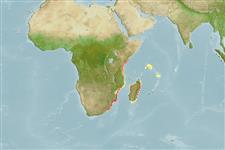Environment: milieu / climate zone / depth range / distribution range
Ökologie
seewasser riff-verbunden; tiefenbereich 20 - 100 m (Ref. 4387). Subtropical
Western Indian Ocean: occurs only in Mozambique and Natal, South Africa.
Size / Gewicht / Alter
Maturity: Lm ? range ? - ? cm
Max length : 60.0 cm TL Männchen/unbestimmt; (Ref. 4387); common length : 40.0 cm TL Männchen/unbestimmt; (Ref. 9660)
Rückenflossenstacheln (insgesamt) : 11; Rückenflossenweichstrahlen (insgesamt) : 20 - 24; Afterflossenstacheln: 3; Afterflossenweichstrahlen: 14 - 17. Adults dark grey in color; juveniles yellow with black bars (very similar to young Diplodus cervinus hottentotus.
Occur in coastal rocky and coral reefs to a depth of 100 m; juveniles pelagic in currents (Ref. 4332). Benthic omnivores. May live longer than 10 years. Spawning occurs throughout the year (Ref. 57746). Marketed fresh (Ref. 9660).
Life cycle and mating behavior
Maturities | Fortpflanzung | Spawnings | Egg(s) | Fecundities | Larven
Heemstra, P.C., 1986. Oplegnathidae. p. 632-633. In M.M. Smith and P.C. Heemstra (eds.) Smiths' sea fishes. Springer-Verlag, Berlin. (Ref. 4387)
IUCN Rote Liste Status (Ref. 130435)
Bedrohung für Menschen
Harmless
Nutzung durch Menschen
Fischereien: kommerziell; Sportfisch: ja
Tools
Zusatzinformationen
Download XML
Internet Quellen
Estimates based on models
Preferred temperature (Ref.
123201): 23.6 - 26.7, mean 25.8 °C (based on 16 cells).
Phylogenetic diversity index (Ref.
82804): PD
50 = 0.5156 [Uniqueness, from 0.5 = low to 2.0 = high].
Bayesian length-weight: a=0.01995 (0.00906 - 0.04395), b=3.01 (2.83 - 3.19), in cm total length, based on all LWR estimates for this body shape (Ref.
93245).
Trophic level (Ref.
69278): 3.2 ±0.42 se; based on food items.
Widerstandsfähigkeit (Ref.
120179): niedrig, Verdopplung der Population dauert 4,5 - 14 Jahre. (tmax > 10).
Fishing Vulnerability (Ref.
59153): Moderate vulnerability (44 of 100).
